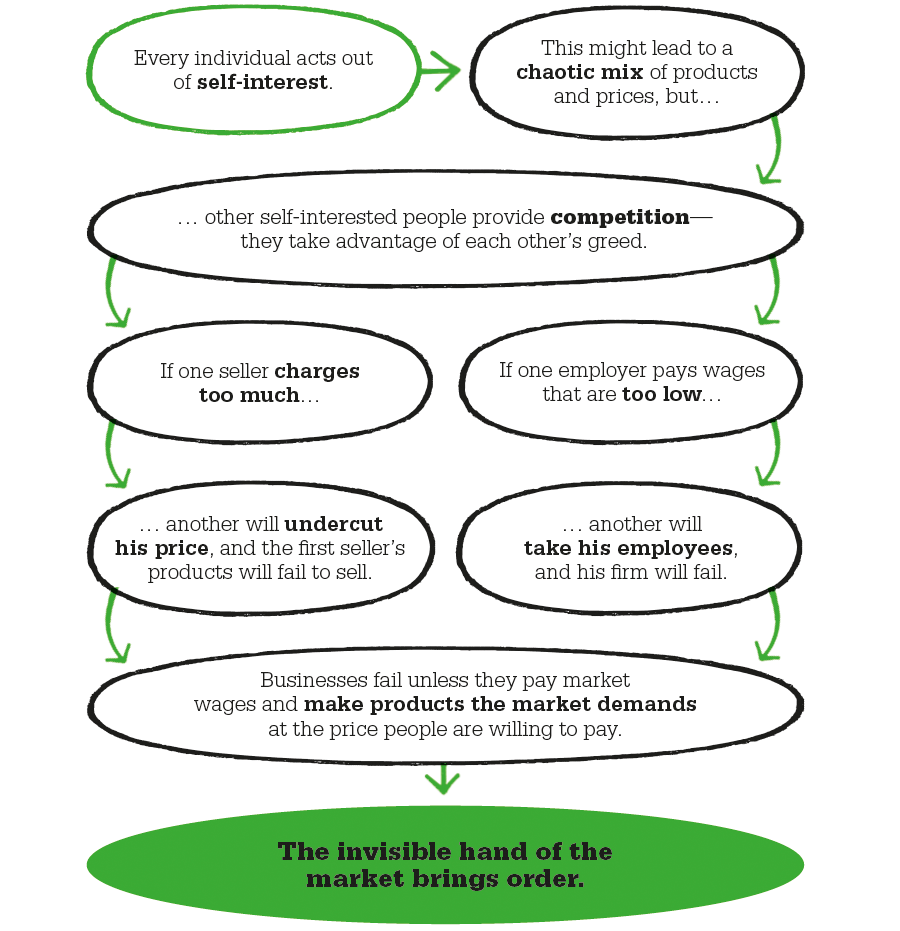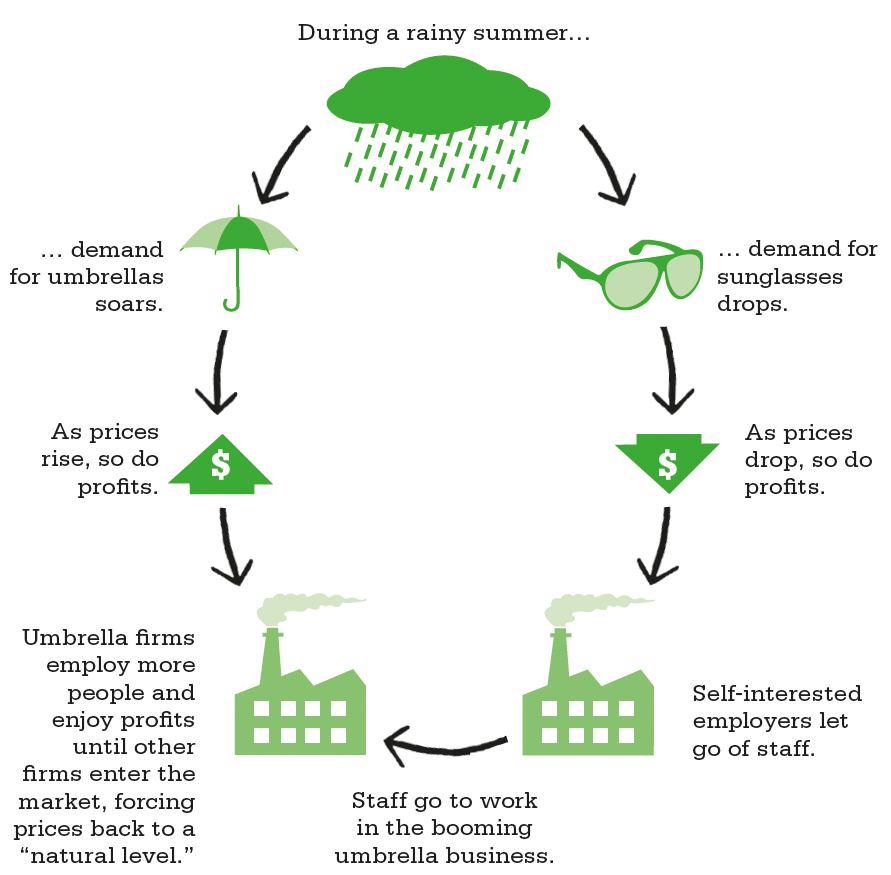

Markets and firms
Adam Smith (1723–90)
1714 Dutch writer Bernard Mandeville illustrates the unintended consequences that can arise from self-interest.
1755–56 Irish banker Richard Cantillon describes a version of “spontaneous order.”
1874 Léon Walras shows how supply and demand lead to a general equilibrium.
1945 Austrian economist Friedrich Hayek argues that market economies produce an efficient order.
1950s Kenneth Arrow and Gérard Debreu identify conditions under which free markets lead to socially optimal outcomes.
According to the Scottish thinker Adam Smith, the West had embarked on a great revolution before the 18th century, with nations changing from agrarian, or agricultural, societies to commercial ones. During the Middle Ages towns had developed, and they were slowly joined up by roads. People brought goods and fresh produce to the towns, and the markets—with their buying and selling—became a part of life. Scientific innovation produced reliable, agreed-upon units of measurement, along with new ways of doing things, and centralized nation-states formed from the mix of principalities that had dotted Europe. People enjoyed a new freedom and had begun to exchange goods for their own personal gain, not merely for that of their overlord.

Smith asked how the actions of free individuals could result in an ordered, stable market—where people could make, buy, and sell what they wanted without enormous waste or want. How was this possible without some kind of guiding hand? In his great work of 1776, The Wealth of Nations, he provided the answer. Man, in his freedom, rivalry, and desire for gain, is “led by an invisible hand to promote an end, which was no part of his intention”—he inadvertently acts on behalf of the wider interest of society.

Covent Garden Market in London is pictured here in 1774. Smith thought markets were key to making society fair. With the freedom to buy and sell, people could enjoy “natural liberty.”
The idea of “spontaneous order” was not new. It was proposed in 1714 by the Dutch writer Bernard Mandeville in his poem The Fable of the Bees. This told the story of a beehive that was thriving on the “vices” (self-interested behavior) of its bees. When the bees became virtuous (no longer acting in their own self-interest but trying to act for the good of the hive), the beehive collapsed. Smith’s notion of self-interest was not a vicious one. He saw humans as having an inclination to “truck and barter” (bargain and exchange) and to better themselves. Humans, in his view, were social creatures who act with moral restraint, using “fair play” in competition.
Smith believed that governments should not interfere with commerce, a view that was also held by other Scottish thinkers around him, including the philosopher David Hume. An earlier French writer, Pierre de Boisguilbert, used the phrase laisse faire la nature (“leave nature alone”), by which he meant “leave business alone.” The term “laissez-faire” is used in economics to advocate minimal government. In Smith’s view government did have an important role, supplying defense, justice, and certain “public goods” that private markets were unlikely to provide, such as roads.
Smith’s vision was essentially optimistic. The English philosopher Thomas Hobbes had earlier argued that without strong authority, human life would be “nasty, brutish, and short.” British economist Thomas Malthus looked at the market and predicted mass starvation as a direct result of increased wealth. After Smith, Karl Marx would predict that the market leads to revolution. Smith, however, saw society as perfectly functional, and the entire economy as a successful system, an imaginary machine that worked. He mentioned the “invisible hand” only once in his five volume work, but its presence is often felt. Smith described how his system of “perfect liberty” could have positive outcomes. First, it provides the goods that people want. If demand for a product exceeds its supply, consumers compete with each other to drive the price up. This creates a profit opportunity for producers, who compete with each other to supply more of the product.
This argument has stood the test of time. In an essay in 1945, titled The Use of Knowledge in Society, the Austrian economist Friedrich Hayek showed how prices respond to individuals’ localized knowledge and desires, leading to changes in the amounts demanded and supplied in the market. A central planner, Hayek said, could not hope to gather up so much dispersed information. It is widely believed that communism collapsed in Eastern Europe because central planning failed to deliver the goods that people wanted. Some criticisms of Smith’s first point have been raised, such as the fact that the market might only provide the goods that are wanted by the rich; it ignores the desires of the poor. It also responds to harmful desires—the market can feed drug addiction and promote obesity.

Mandeville’s Fable of the Bees explored the idea that when people act out of self-interest, they benefit the whole of society, like the self-interested behavior of bees benefits the hive.
Second, Smith said that the market system generates prices that are “fair.” He believed that all goods have a natural price that reflects only the efforts that went into making them. The land used in making a product should earn its natural rent. The capital used in its manufacture should earn its natural profit. The labor used should earn its natural wage. Market prices and rates of return can differ from their natural levels for periods of time, as might happen in times of scarcity. In that case, opportunities for gain will arise, and prices will increase, but only until competition brings new firms into the market and prices fall back to their natural level. If one industry begins to suffer a slump in demand, prices will drop and wages will fall, but as a different industry rises, it will offer higher wages to attract workers. In the long run, Smith says, “market” and “natural” rates will be the same: modern economists call this equilibrium.
"Consumption is the sole end and purpose of all production."
Adam Smith
Competition is essential if prices are to be fair. Smith attacked the monopolies occurring under the mercantilist system, which demanded that governments should control foreign trade. When there is only one supplier of a good, the firm that supplies it can permanently hold the price above its natural level. Smith said that if there are 20 grocers selling a product, the market is more competitive than if there are just two. With effective competition and low barriers to entry into a market—which Smith also said was essential—prices tend to be lower. Much of this underlies mainstream economists’ views about competition, although dissenters, such as Austrian-American economist Joseph Schumpeter, would later say that innovation can also lower prices, even where there appears to be little competition. As inventors come forward to provide higher quality products at lower prices, they blow away existing firms in a storm of creative destruction.

Demand in a market can change for many reasons. As it does so, the market responds by altering supply. This happens spontaneously—there is no need for a guiding hand or plan in a market that encourages competition among self-interested people.
Smith also argued that market economies provide incomes that are fair and can be spent on goods in a sustainable “circular flow,” in which money paid in wages circulates back into the economy when the worker pays for goods, only to be paid back out in wages to repeat the process. Capital invested in production facilities helps to increase labor productivity, which means that employers can afford to pay higher wages. And if employers can afford to pay more, they will because they have to compete with each other for workers.
Turning to capital, Smith said that the amount of profit that capital can expect to earn through investments is roughly equal to the rate of interest. This is because employers compete with each other to borrow funds to invest in profitable opportunities. Over time the rate of profit in any particular field falls as capital accumulates and opportunities for profit are exhausted. Rents gradually rise as incomes rise and more land is used.
Smith’s realization of the interdependence of land, labor, and capital was a real breakthrough. He noted that workers and landowners tend to consume their incomes, while employers are more frugal, investing their savings in capital stock. He saw that wage rates vary, depending on different levels of “skill, dexterity, and judgment,” and that there are two forms of labor: productive (engaged in agriculture or manufacturing) and what he called “unproductive” (supplying services needed to back up the main work). The highly unequal outcomes of today’s market system are a long way from what Smith envisioned.
Smith claimed that the invisible hand itself stimulates economic growth. The source of growth is twofold. One is the efficiencies gained through the division of labor. Economists call this “Smithian growth.” As more products are produced and consumed, the economy grows, and markets also grow. As markets grow, there are more opportunities for specialization of work.
"It is not from the benevolence of the butcher, the brewer, or the baker that we expect our dinner, but from their regard to their self-interest."
Adam Smith
The second engine of growth is the accumulation of capital, driven by saving and the opportunity for profit. Smith said that growth can be reduced by commercial failures, a lack of resources required to maintain the fixed capital stock, an inadequate money system (there is more growth with paper money than with gold), and a high proportion of unproductive workers. He claimed that capital is more productive in agriculture than in manufacturing, which is higher than in trade or transport. Ultimately, the economy will grow until it reaches a wealthy, stationary state. In this, Smith underestimated the role of technology and innovation—the Schumpeterian growth described in the section Fair prices.

Smith described the ways in which labor, landowners, and capital (here invested in the horses and plow) work together to keep the economic system moving and growing.
Smith’s system was comprehensive. It considered small (microeconomic) details and the large (macroeconomic) picture. It looked at situations in both the short and long run, and its analysis was both static (the state of trade) and dynamic (the economy in motion). It looked in detail at the class known as workers, distinguishing entrepreneurs such as farmers and factory owners from suppliers of labor. In essence it established the parameters for “classical” economics, which focuses on the factors of production—capital, labor, and land—and their returns. Later, free market theory took a different, “neoclassical” form with general equilibrium theory, which sought to show how a whole economy’s prices could reach a state of stable equilibrium. Using mathematics, economists such as Léon Walras and Vilfredo Pareto reframed Smith’s claim that the invisible hand would be socially beneficial. Kenneth Arrow and Gérard Debreu showed how free markets do this, but they also showed that the conditions needed were stringent and did not bear much relation to reality.
"There is no art which one government sooner learns of another than that of draining money from the pockets of the people."
Adam Smith
This was not the end of the story. After World War II the idea of laissez-faire was in hibernation. However, from the 1970s, Keynesian policies, which advocated state intervention in economies, seemed to break down, and laissez-faire enjoyed a strong resurgence. The seeds of this flowering can be found in works on the market economy by Milton Friedman and the Austrian School, notably Friedrich Hayek, who were skeptical about the good that interfering governments can do and argued that social progress would be attained through unfettered markets. Keynesians, too, recognized the power of markets—but for them markets needed to be nudged to work best.
"Human society, when we contemplate it in a certain abstract and philosophical light, appears like a great, an immense machine."
Adam Smith
The free market approach enjoyed an important boost from theories in the 1960s and 70s based on the role of rationality and rational expectations. Public choice theory, for example, depicts government as a group of self-seeking individuals who maximize their own interests and extract money without regard to the social good (“rent-seeking”). New classical macroeconomics uses Smith’s assumption that markets always sort themselves out and adds the point that people can see the future implications of any government actions and understand the workings of the economic system, so state intervention will not work. Even so, most economists today believe that the market can fail. They focus on disparities in information, held by various participants in a market. George Akerlof referred to this in his The Market for Lemons. Behavioral economists have questioned the whole notion of rationality, and see the non-rationality of humans as a reason for markets to fail.
The issue of laissez-faire economics divides economists along political lines. Those on the political Right embrace laissez-faire; those from the Left align themselves with Keynesian intervention. This remains a central debate in economics today.
The financial crisis of 2007–08 has added fuel to this dispute. The free marketeers felt vindicated in their theories about the business cycle, while Keynesians pointed to market failure. US economist Nouriel Roubini (1959–), who predicted the crash, was speaking of those who had distorted Smith’s ideas when he said that “decades of free market fundamentalism laid the foundation for the meltdown.”

Localized markets such as this one in Kerala, India, exhibit all the hallmarks of Smith’s free market and demonstrate the natural way in which supply and price adjust to demand.

Smith didn’t foresee the kinds of inequalities that can arise from free markets in their present form. In stock exchanges and money markets notions of “fairness” become almost irrelevant.

The founder of modern economics, Adam Smith was born in Kirkcaldy, Scotland, in 1723, six months after his father’s death. A reclusive, absentminded scholar, he went to Glasgow University at the age of 14, then studied at Oxford University for six years before returning to Scotland to take up a professorship in logic at Glasgow University. In 1750, he met and became close friends with the philosopher David Hume.
In 1764, Smith resigned his post at Glasgow to travel to France as tutor to the Duke of Buccleuch, a Scottish aristocrat. In France, he met the physiocrat group of economists and the philosopher Voltaire, and he began writing The Wealth of Nations. He devoted 10 years to the book before accepting a position as Commissioner of Customs. He died in 1790.
1759 The Theory of Moral Sentiments
1762 Lectures on Jurisprudence
1776 An Inquiry into the Nature and Causes of the Wealth of Nations